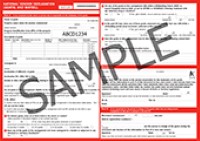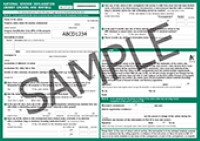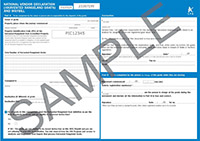
How-to guides
The mobile-friendly eNVD system and mobile app is available for LPA accredited producers, feedlots and value chain stakeholders to use.
It is fast, easy and more accurate than paper forms.
Learn how to use the eNVD web platform or mobile app.

FAQs
The current version of the LPA NVD is ‘0720’.
Download sample versions and tips to ensure your NVDs are clear, correct and complete.
Log in to your LPA account via myMLA and order your NVDs online. If you are unable to access your account, please call ISC Customer Service on 1800 683 111 to order over the phone.
Log-in to your LPA account and order online
1. Log into your LPA account via myMLA.
2. Click on the order books link.

- Choose the number of books you would like to order.

- Then select ‘checkout’ to finalise the order. You can also track your order through Australia Post.
Producers can use either the paper or electronic eNVD at any time – and can alternate between both options. It depends on what you feel most comfortable using.
The eNVD and hard copy NVD version are identical. You should be aware that if you are audited, you will need to have the hard copies on hand if you are using the printed version of the eNVD.
The eNVD is an alternate faster and easier online option – and it is free. Many producers have used it while waiting for their new paper NVD books to arrive and have decided to keep using it.
Hard copy versions of the NVD will remain available for the foreseeable future.
The NVD versions for all species are reviewed on an annual basis by both industry and government through SAFEMEAT.
To suggest changes for consideration through SAFEMEAT, contact your producer representation body – either Cattle Council of Australia, Sheep Producers Australia, or the Goat Industry Council of Australia or if you are a transporter, the Australian Livestock and Rural Transporters Association. These groups put forward suggested changes and agree on what needs to be included. ISC is then tasked with rolling out the changes.
Where changes are requested, they will go through the annual process and, once agreed upon by all parties, will be rolled out through a 12-month notification period. ISC recommends only purchasing a maximum 12-month supply to ensure you are always using up-to-date LPA NVDs.
Meanwhile, the National Health Declaration is administered by Animal Health Australia and reviewed using the national SAFEMEAT process. When there are changes to that declaration, ISC makes these updates in our systems where required.
- Your LPA NVD book should arrive within 28 days of placing an order.
- You can track the progress of your LPA NVD book delivery once it is lodged with Australia Post. The tracking number is available via your LPA account within the ‘Purchase History’
- If you prefer to use a LPA NVD book, orders need to be placed well in advance. If this is not possible then an eNVD will need to be used.
Integrity Systems Company (ISC) conducts an annual review of NVDs through the SAFEMEAT consultation process.
During this review, if SAFEMEAT determines there is a need to amend the NVD to reflect food safety or legislative requirements, then a new version of the NVD will be issued, making previous NVD versions redundant.
Producers will be notified 12 months in advance of any NVD versions being made redundant.
The consignee and destination can have different PICs. If transporting livestock to be sold at a saleyard, the consignee is the agent and the destination is the saleyard location. You need to ensure the destination PIC of the saleyard and its full physical address is included in the destination location.
Learn more about how to consign livestock correctly on the NVD.
The ‘number of electronic devices’ field on the NVD is included because some producers may be selling mixed mobs of sheep that have both EID and visual tags. These mixed mobs could include:
- older sheep that do not have electronic NLIS (sheep) devices
- lambs that do have electronic NLIS (sheep) tags
- non-vendor bred interstate sourced sheep that have visual tags.
Question 1 on the sheep LPA NVD is: ‘Have these sheep or lambs been raised consistent with the rules of an independently audited QA program on the property the PIC of which is shown above?’ This specifically relates to independently audited QA programs such as LPA QA, otherwise known as Flockcare, as well as other industry-wide programs that are branded based on a breed or region that you may be part of. Find out more about Flockcare and Cattlecare.
Question 1 on the cattle LPA NVD is: ‘Have any of the cattle in this consignment ever in their lives been treated with hormonal growth promotants (HGP)?’ You should tick yes on Question 1 of the NVD if:
- you are in doubt
- your farm records say yes
- any of the animals have a triangular hole in their right ear
- you can see or feel an old implant or a steel bead in their right ear.
You should only tick no if you are absolutely certain animals have not been treated with HGPs. Remember both male and female cattle can be treated with HGPs.
On the EU cattle NVD, the declaration section specifies that:
- none of the animals have ever been treated with HGPs
- there are records available to demonstrate that the animals were either:
- born on the property the PIC of which is shown
- or (for purchased cattle) accompanied by an EU vendor declaration attesting to their HGP freedom.
Don’t forget that cattle treated with HGPs must be identified by a triangular ear punch so they can be kept separate where necessary. Some customers and markets do not want to buy meat that has been treated with HGPs.
Read more about HGPs and completing the LPA NVD.
Question 1 on the goat LPA NVD is: ‘For farmed goats, were all of them bred by the owner or vendor?’ It is required to be filled out with the minimum time stock have been on your property. If any stock in a consignment have been purchased, then the timeline refers to the most recent purchase.
If you have a mixed consignment of 50% vendor-bred and 50% purchased, you must tick no and select the time range that the purchased stock have been on your PIC. Alternatively, if you are able to separate the consignment you could use two NVDs identifying which consignment is vendor-bred or purchased.
Question 3 on the LPA NVD for sheep and cattle refers to whether the owner has bred/owned the stock since their birth. It is required to be filled out with the minimum time stock have been on your property. If any stock in a consignment have been purchased, then the timeline refers to the most recent purchase.
If you have a mixed consignment of both vendor bred and purchased livestock, you must tick no and select the time range that the purchased stock have been on your PIC. Alternatively, if you are able to separate the consignment you could use two NVDs identifying which consignment is vendor bred or purchased.
You may have stock that have been born on one property you own and transferred to another you own – but the properties are managed by you in the same way. If this is the case, then you can answer ‘yes’ to question 3 on the NVD – that the stock have been owned by the same owner since birth – even though animals are being sent from a non-birth PIC.
If you have done an internal property transfer between the two PICs then ISC recommends adding a reference in the additional information section of the NVD that ‘livestock have been transferred between PICs within the same ownership’. This helps processors when deeming if livestock are eligible for particular export markets and are lifetime traceable.
To comply with LPA requirements, all movements of livestock from one PIC to another – even if owned by the same entity – must be recorded on an LPA NVD and the NLIS database.
There are two reasons for this. Firstly, any food safety information associated with the animals must be retained for reference to accompany or provide historical evidence of risks for any further movements.
Second, a system error will be generated for a PIC if a movement is not recorded of the individual animal. For example, a producer owns a breeding property (PIC A) and fattening property (PIC B). The fattening stock are tagged with NLIS tags from PIC A – their property of birth and are sent to PIC B once weaned. An LPA NVD and NLIS transfer must be completed so the database is notified of the physical location of the animals and in this case, is PIC B.

When these animals are sent to sale or slaughter from PIC B, an NLIS transfer is completed by the receiver (PIC C). If the tags had been transferred from PIC A to PIC B, the animals retain their lifetime traceability.
Without the transfer between PIC A and PIC B, a system error will automatically be generated and the animals would lose their lifetime traceability
System errors will be investigated in an LPA audit. To remain LPA-accredited, you must be able to demonstrate that you are using an LPA NVD and completing an NLIS transfer for all movements between your PICs.
More information about your requirements when owning properties with different PICs.
An export slaughter interval (ESI) is the period that must lapse between chemical application to livestock and their slaughter for export. Compliance with the ESI means that the slaughtered livestock will meet the residue limits which apply in all export markets. ESIs are revised throughout the year, which means the ESI printed on your LPA NVD may be out of date. For the latest version, visit www.apvma.gov.au/esi.
The withholding period (WHP) for meat is the minimum time after an animal is treated with a veterinary medicine or pesticide before it may be legally slaughtered for human consumption. Withholding periods are set to ensure that chemical residues, if any, in the carcase are below the maximum residue limit allowed for that chemical in food in Australia. In general, slaughter and feeder animals should not be treated with a veterinary drug if the withholding period exceeds the expected date of departure from a property.
Product labels can be viewed on the PubCRIS database.
Restricted animal material (RAM) includes meat, meat and bone meal, blood meal, blood and bone meal, dog biscuits, poultry offal meal, feather meal, fishmeal or any other animal meals or manures to livestock.
The feeding of RAM to ruminant animals has been linked to the spread of Bovine Spongiform Encephalopathy (BSE). Livestock should not be fed such products.
To minimise the risk of contaminating our meat supply, it is important to keep and store products that may contain RAM separate from feed that will be fed to ruminant livestock.
Producers no longer need to declare these terms on NVDs. If producers are correctly answering the LPA NVD questions regarding withholding periods (WHP) and export slaughter intervals (ESI) then processors will know for which markets the animals are suited.
You will need to use a National Vendor Declaration (NVD) (bobby calves) and waybill, identified by version number BC0720.
The person responsible for the management of the livestock should be completing the NVD to ensure all questions, specifically regarding food safety, are answered correctly. If the owner doesn’t have responsibility for the management of the animals, the sharefarmer should complete the NVD on their behalf.
If there is no transport involved but the animals are moving from one PIC to another – for example, they are being walked between properties, then make a note of this in the transport section. If the animals are being sold and there is a transfer of ownership but they are remaining on the same PIC then technically no NVD is required as no transfer is taking place. However, if the preference is to complete an NVD in this instance then note the circumstances on the NVD.
EUVD is the European Union Vendor Declaration, a type of LPA NVD that must accompany all movements of EU-accredited cattle between different PICs.













